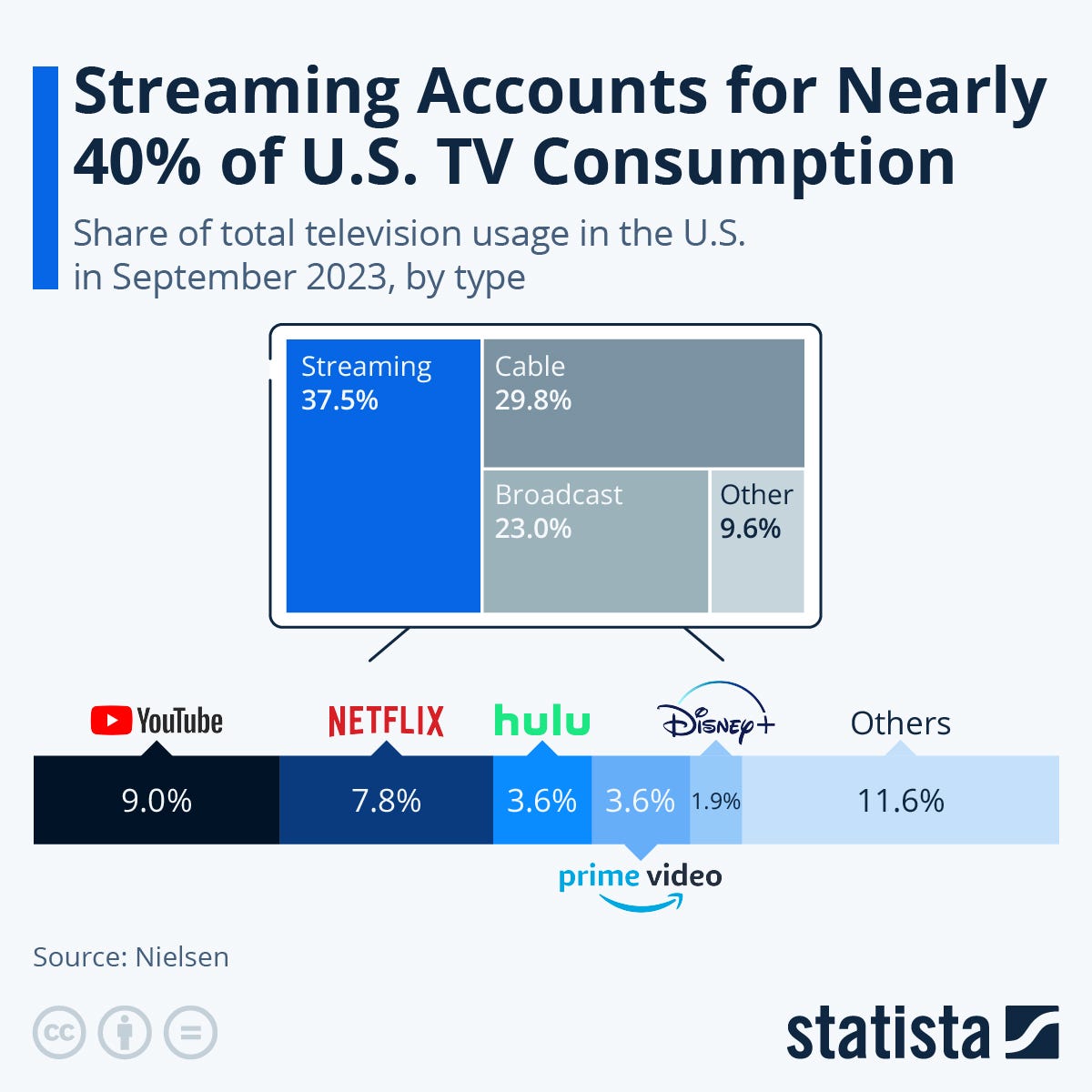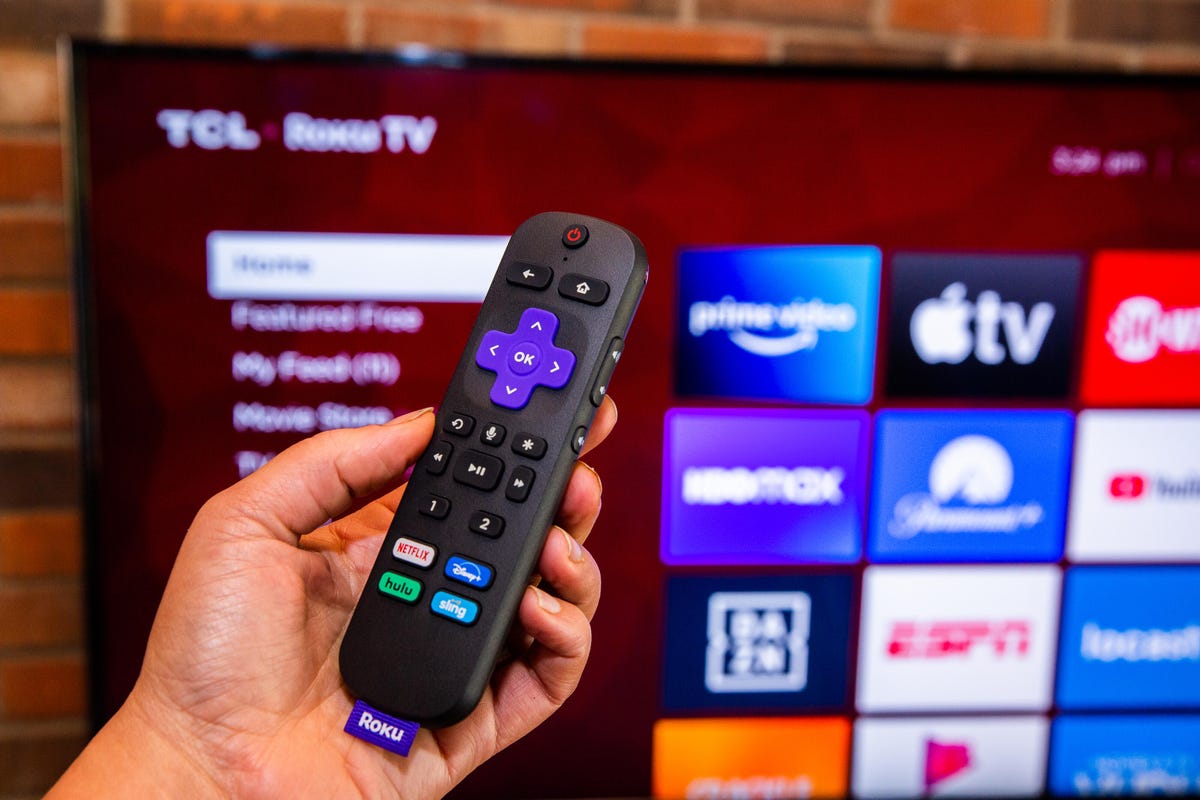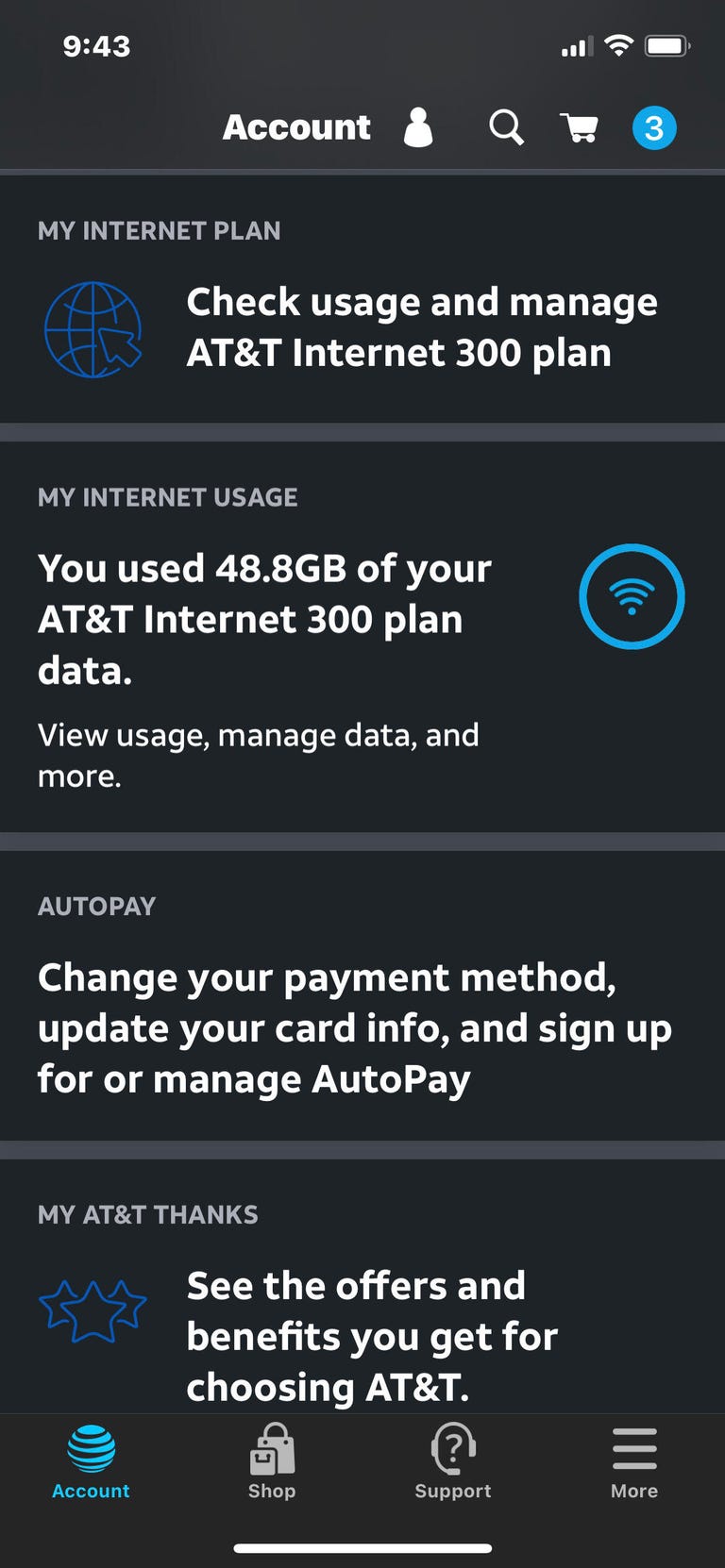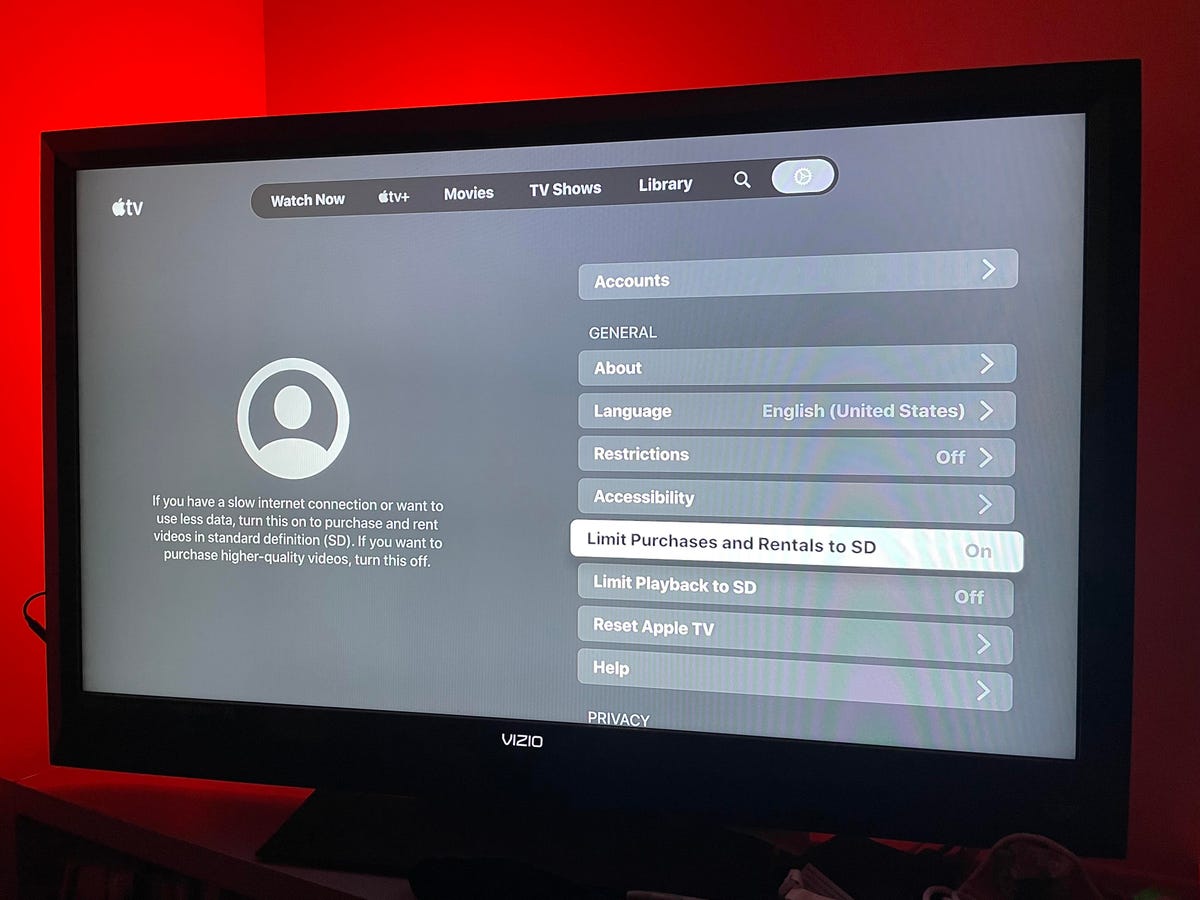 Why You Can Trust CNET
Why You Can Trust CNET
Our expert, award-winning staff selects the products we cover and rigorously researches and tests our top picks. If you buy through our links, we may get a commission. How we test ISPs
According to the latest data from Statista, approximately 83% of US consumers use at least one streaming service, up by more than 10% in the last five years. In addition, recent findings in an OpenVault report from the second quarter of 2024 show the average American household uses 586GB of data per month and spends an average of three hours streaming digital media. Plus, 18% of internet users are described as "Power Users," averaging more than 1TB of data a month.

This chart breaks down the total usage of television in the US from September of last year.
Nielsen/StatistaThat's all well and good, but several internet providers, including prominent names such as AT&T, Cox, Mediacom and Xfinity enforce data caps with some of their plans, some as low as 400GB. If you're saddled with an internet plan that has a data cap, you'll need to ration your internet data consumption each month. Browse, stream or download too much, and you'll risk overage charges on your next bill. With some plans, breaking the cap means your connection will get throttled to a snail's pace for the remainder of the month.
Internet is already expensive. Coupled with the fact that we're not always getting the speeds we paid for, caveats like data caps make internet all the more frustrating. I don't mean to launch into a diatribe against data caps (that's a whole other article), but the hard truth is that many of us have no choice but to live with them. If that's the case for you, you'll need a good strategy for managing that data cap. Here are some basic steps to get you off to the right start.
First things first: What are data caps?
Let's start at the beginning. Data caps are limits set by your internet service provider on your monthly internet usage. The idea is that there's a limited amount of bandwidth on the provider's network, so the data cap is meant to ensure that no one customer or subscriber takes up more than their fair share of that bandwidth.
The gauge for measuring that data usage is bytes. Whereas bits measure the speed of the data as it's transferred -- 200 megabits per second, for example -- bytes measure the data's size (1 byte is 8 bits). Information is tracked in ascending order of kilobytes, megabytes, gigabytes and terabytes. When abbreviated, bits take a small b and bytes a capital B, so you'll see 1Mbps (1 megabit per second) but 1MB (1 megabyte).
The lower the data cap, the less you'll be able to do on the internet before your ISP begins to either throttle your service(which means slowing down the speed of your internet connection) or charge you extra fees for exceeding your data limit. In some cases, it might even do both.
Why am I going over the basics? One of the best ways to handle a data cap on your home internet plan is to understand it better.
Which providers enforce a data cap?
Here at CNET, we've reviewed every ISP with internet service available to at least 10 million people in the US. Among them, here are the providers that enforce a data cap:
Internet providers compared
Show more (3 items)
Source: CNET analysis of provider data.
Many more providers across the country impose data caps on their customers, but these are some of the biggest ISPs that enforce limits on your home internet service.
Research ISPs and your own data usage
If you currently have a broadband provider imposing a data cap on your internet service, your first step should be researching if your address is serviceable for another provider. You can save yourself a lot of hassle if you sign up with an ISP with no data caps in the first place.
If that isn't an option, you can start by figuring out how much data your typical online activities use. In CNET's internet speed guide, we include recommendations for the type of speed you'll need for various online activities. Let's revisit that chart, but add the amount of data you'll typically use for each activity.
Internet speed recommendations
| Activity | Usage required | Our recomended speed |
|---|---|---|
| 1Mbps | 1Mbps | |
| Web browsing | 3-5Mbps | 5-10Mbps |
| Social media | 3-5Mbps | 10Mbps |
| Video calls | 3-5Mbps | 10-20Mbps |
| HD streaming | 5-10Mbps | 10-20Mbps |
| Online gaming | 3–6Mbps | 25-35Mbps |
| 4K streaming | 25Mbps | 35Mbps |
Show more (2 items)
Admittedly, that's a lot of numbers. It can also feel a little esoteric and difficult to grasp.
According to the OpenVault broadband study I mentioned earlier, the average US household uses approximately 586GB of data monthly. For context, at the peak of 2020, average in-home data usage spiked to 18% per month. During the fourth quarter of 2023, internet usage jumped to 641GB. Although current average usage is slightly below those numbers, household usage is still projected to climb in the coming years, especially as our world becomes increasingly online.
If you have a provider like Cox or Xfinity, where your data cap is approximately 1.2TB (1,200GB), you're probably not bumping against your data allowance too often. Other ISPs -- especially on cheaper, more introductory plans -- feature limits in the 40GB-to-300GB range, which is far below what the average American household uses and would require some belt-tightening, as it were.
Once you build some awareness of how much data your typical activities eat up, you can also start to anticipate when your data consumption might increase.

Binge with caution: Streaming TV and movies in 4K is one of the fastest ways to burn through your data allotment.
Sarah Tew/CNETI'll give you an example from my own experience. During the pandemic, my wife and I indulged in a new 4K TV and Sonos system to make the most of our shelter-at-home experience. After all, if I'm going to watch Dune or The Batman from my couch instead of at the movie theater, I want to have a theatrical-adjacent type of experience, complete with crisp, bright images and booming surround sound.
That also meant we had to upgrade our Netflix subscription to take advantage if we wanted to watch Stranger Things or The Great British Baking Show in Dolby Vision. According to Netflix, that move meant we doubled our data usage. Instead of using 3GB per hour with each program, we were now eating up data at a rate of 7GB per hour of viewing.
Do we regret it? Not at all. We went into it with our eyes wide open about the data usage cost we would incur, which meant we could prepare for it. We definitely would have had sticker shock after our extensive quarantine binge sessions if we had been unaware.
If your family also likes to stream in 4K but you also have gamers, remote workers or students in the house, you should definitely closely evaluate how much data your household is using up each month.
Check yourself by monitoring your usage

Download your internet provider's app and log in to monitor your data usage throughout the month.
Screenshot by Ry Crist/CNETIt's one thing to know how much data certain activities use up. It's another to stay on top of how much you use. Just as we might be shocked by how many calories we consume in a day once we start to pay attention, we might similarly be stunned by what's gobbling up our data.
There are many different ways to track your data usage, but perhaps the easiest is to download and use your ISP's app. One big reason is that this is how your provider tracks your usage and what it's holding you accountable for. This will allow you to stay on top of things and pace yourself for your billing cycle, which is crucial because, in most cases, your data usage isn't tracked by the calendar month but by a rolling 30-day cycle. Your ISP's app will help you sync up correctly with that window.
You can also track your usage by using the settings on your router. I mention this mainly for those who might be using their own equipment rather than the modem/router rental from the provider. It's a good way of checking your usage against the provider's app and helping you see if there are any inconsistencies.
Plan ahead to maximize your data usage
Now that you have a better idea of the amount of data you tend to use, you can start to think several steps ahead about what you need to do to maximize the use of your monthly data allowance.
Let's go back to the example of my streaming services splurge. I intentionally increased my data usage to take advantage of streaming in 4K, but you can also go the other way to help minimize the dent in your data allowance.
Let's say you want to catch up on episodes of Lord of the Rings: The Rings of Power on your tablet while your roommate watches something else on the TV. You can go to Prime Video settings and lower the video quality, so you're streaming in standard definition rather than HD or 4K. You can do this for Disney Plus, Facebook, Hulu, YouTube and other services.

Most streaming apps include options for limiting the amount of data they use, though that typically means passing on HD and 4K. Here's the setting with Apple TV Plus.
Ry Crist/CNETAlso, take the time to explore what options your provider might have to help you massage your data cap.
The bottom line: Be disciplined, but realistic
It's fair to say that we all have moments when we must recline on the couch and binge to our heart's content. No judgment here. When all's said and done, if you've done the work -- taken advantage of various bonus times and opportunities to downgrade some of your activities to use up less data -- and still find you're exceeding your data cap, maybe it's time to upgrade to a plan with unlimited data.
Most ISPs will typically charge you $10 for every 50GB you burn through over your data cap. In most cases where there's an option for unlimited data, it'll cost you an additional $30 to $40 per month. If you're paying $50 or more in overage fees on average, it's time to consider paying up front instead.
If unlimited data isn't an option with your provider, you're in a more challenging spot. In that case, it's a good idea to start by exploring other options to see if another provider might be a better data fit, even if the speeds are slower. If there aren't any options like those available at your address, you'll need to keep a frugal data budget to avoid the extra fees that come with breaking your cap. Maybe that means binging your next series via DVD or Blu-ray, scheduling your downloads for the wee hours of the morning or limiting your internet usage to essential functions like staying connected with family and paying bills. Whatever the case, understanding the ins and outs of your plan and how you rack up data during the month is the key to making it work.
How to manage your data cap FAQs
Is it possible to change my data cap?
Yes. Most internet service providers that enforce a data cap will allow their customers to purchase additional data either incrementally (for example, Cox Internet allows customers to add unlimited and 50GB of data for an additional charge) or via unlimited data, which often costs an additional $10 to $30 per month. If you typically stay within your data cap and only occasionally get charged a $5 or $10 overage fee, then splurging for unlimited data would be a bad deal. If you're getting hit with additional fines of $40 to $100 per month (and most ISPs will cap their monthly overage fees at around $100), you should seriously consider purchasing unlimited data.
Are there any advantages to having a data cap?
No. Next question? Seriously, most advantages of having a data cap go to the internet service provider, not the customer. In some cases (but not many), you might save a little money on your monthly bill by having a data cap. The growing number of ISPs that feature unlimited data -- including 5G home internet, which is becoming more widely available -- makes it highly unlikely that you'll save money in the long term by having a data cap.
Which internet providers don't enforce a data cap?
Thankfully, the number of internet service providers that don't enforce a data cap is much higher than those that do. For example, although certain AT&T internet plans have a data cap, none of its AT&T Fiber plans do. Other notable ISPs that have unlimited data include (but are not limited to): CenturyLink, Frontier, Google Fiber, Metronet, Optimum, Spectrum, Starlink, Starry Internet, T-Mobile Home Internet, Verizon Fios, Verizon 5G Home Internet, Ziply Fiber and many more.